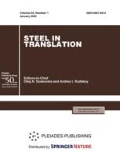Abstract
Fe–Ni alloys are widely used in engineering today. They are sometimes alloyed with boron. Oxygen is a harmful impurity in Fe–Ni alloys. It may be present in dissolved form or as nonmetallic inclusions. The presence of oxygen in Fe–Ni alloys impairs their performance. Research on the thermodynamics of oxygen solutions in Fe–Ni melts containing boron is of considerable interest in order to improve alloy production. The present work offers a thermodynamic analysis of solutions of oxygen in Fe–Ni melts containing boron. The equilibrium constant of the reaction between boron and oxygen dissolved in the melt in such systems is determined. The activity coefficients at infinite dilution and the interaction parameters in melts of different composition are also calculated. When boron reacts with oxygen in Fe–Ni melts, the oxide phase contains not only B2O3 but also FeO and NiO. The mole fractions of B2O3, FeO, and NiO in the oxide phase are calculated for different boron concentrations in Fe–Ni melts at 1873 K. For iron melts with low boron content, the mole fraction of boron oxide is ~0.1. With increase in the nickel and boron content in the melts, the boron-oxide content in the oxide phase increases. Its mole fraction is close to one for pure nickel. The solubility of oxygen in Fe–Ni melts is calculated as a function of the nickel and boron content. The deoxidizing ability of the boron improve significantly with increase in nickel content in the melt. The curves of oxygen solubility in Fe‒Ni melts containing boron pass through a minimum, which is shifted to higher boron content with increase in nickel content in the melt. The boron content at the minima on the curves of oxygen solubility are determined, as well as the corresponding minimum oxygen concentrations.
Similar content being viewed by others
References
Shlyamnev, A.P., Korrozionnostoikie, zharostoikie i vysokoprochnye stali i splavy. Spravochnik (Corrosion- Resistant, Heat-Resistant and High-Strength Steels and Alloys: Handbook), Moscow: Intermet-Inzhiniring, 2000.
Lyakishev, N.P., Pliner, Yu.L., and Lappo, S.I., Borsoderzhashchie stali i splavy (Boron-Containing Steels and Alloys), Moscow: Metallurgiya, 1986.
Bokshtein, S.Z., Vasilenok, L.B., Kablov, E.N., Radin, I.V., and Ryabova, G.G., Microalloying with boron and the structural stability of nickel alloys, Russ. Metall. (Engl. Transl.), 1986, no. 6, pp. 142–146.
Horton, J.A., McKamey, C.G., Miller, M.K., Cao, W.D., and Kennedy, R.L., Microstructural characterization of superalloy 718 with boron and phosphorus additions, Proc. Sixth Int. Symp. on Superalloys 718, 625, 706 and Various Derivatives, Loria, E.A., Ed., Warrendale, PA: Miner., Met. Mater. Soc., 1997, pp. 401–408.
Steelmaking Data Sourcebook, New York: Gordon- Breach Science, 1988.
Slag Atlas, Düsseldorf: Verlag Stahleisen, 1995.
Turkdogan, E.T., Physical Chemistry of High Temperature Technology, New York: Academic, 1980.
Kulikov, I.S., Raskislenie metallov (Deoxidation of Metals), Moscow: Metallurgiya, 1975.
Belyanchikov, L.N., Universal method for recalculating interaction parameters of elements in changing the matrix of alloys using the quasi-regular solution theory. Part II. Estimating the interaction parameters of elements in nickel–based alloys, Elektrometallurgiya, 2009, no. 2, pp. 29–38.
Wagner, C., Thermodynamics of Alloys, Cambridge, Ma: Addison-Wesley, 1952.
Snitko, Yu.P., Surovoi, Yu.N., and Lyakishev, N.P., On connection of interaction parameters with the atomic characteristics of components, Dokl. Akad. Nauk SSSR, 1983, vol. 286, no. 5, pp. 1154–1156.
Kulikov, I.S., Termodinamika oksidov (Thermodynamics of Oxides), Moscow: Metallurgiya, 1986.
Sigworth, G.K., Elliott, J.F., Vaughn, G., and Geiger, G.H., The thermodynamics of dilute liquid nickel alloys, Can. Metall. Q, 1977, vol. 16, no. 1, pp. 104–110.
Frohberg, M.G. and Wang, M., Thermodynamic properties of sulfur in liquid copper-antimony alloys at 1473 K, Z. Metallkd., 1990, vol. 81, no. 7, pp. 513–518.
Dashevskii, V.Ya., Fiziko-khimicheskie osnovy raskisleniya zhelezonikelevykh splavov (Physicochemical Basis of Deoxidation of Iron-Nickel Melts), Moscow: Fizmatlit, 2011.
Chiang, T. and Chang, Y.A., The activity coefficient of oxygen in binary liquid metal alloys, Metall. Trans. B, 1976, vol. 7, pp. 453–457.
Aleksandrov, A.A. and Dashevskii, V.Ya., Effect of Zirconium on the Oxygen Solubility in Liquid Nickel and Ni–Fe Melts, Russ. Metall. (Engl. Transl.), 2016, vol. 2016, no. 9, pp. 832–838.
Aleksandrov, A.A. and Dashevskii, V.Ya., Thermodynamics of the oxygen solutions in niobium-containing Fe–Ni melts, Russ. Metall. (Engl. Transl.), 2012, vol. 2012, no. 7, pp. 559–566.
Hultgren, R., Desai, P.D., Hawkins, D.T., Gleiser, M., and Kelley, K.K., Selected Values of the Thermodynamic Properties of Binary Alloys, Metals Park: Am. Soc. Met., 1973.
Aleksandrov, A.A. and Dashevskii, V.Ya., Thermodynamics of the oxygen solutions in manganese-containing Fe–Co melts, Russ. Metall. (Engl. Transl.), 2014, vol. 2014, no. 1, pp. 1–7.
Author information
Authors and Affiliations
Corresponding author
Additional information
Original Russian Text © A.A. Aleksandrov, V.Ya. Dashevskii, L.I. Leont’ev, 2018, published in Izvestiya Vysshikh Uchebnykh Zavedenii, Chernaya Metallurgiya, 2018, No. 3, pp. 201–210.
About this article
Cite this article
Aleksandrov, A.A., Dashevskii, V.Y. & Leont’ev, L.I. Thermodynamics of Oxygen Solution in Fe–Ni Melts Containing Boron. Steel Transl. 48, 154–162 (2018). https://doi.org/10.3103/S0967091218030026
Received:
Published:
Issue Date:
DOI: https://doi.org/10.3103/S0967091218030026


